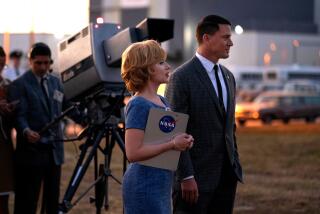BOOK REVIEW : Exploring the Inner Side of Outer Space : EXPLORING SPACE: <i> by William F. Burrows</i> , Random House $24.95 hardcover, 403 pages
- Share via
Isaac Newton would be pleased to see how cleverly JPL engineers have applied his laws of planetary motion. In one of their most spectacular operations, the engineers guided Voyager 2, launched in 1977, to its encounter with Uranus in 1986--a trip of a billion miles--within mere seconds of the time at which it was programmed to arrive.
But if the 17th-Century mathematician were still around, he would have been one of the few to notice the feat, to hear it from the underappreciated engineers. They groused, says William Burrows, author of this fact-packed chronicle of space exploration, that the mission scientists stole the show with their dramatic photo-illustrated reports of unprecedented geological formations.
Space scientists have complaints about the engineers, too, Burrows says. The scientists claim that far too much money is spent on attention-grabbing but scientifically dispensable high-tech missions involving humans in space, naming in particular the Apollo moon shots, the space shuttle and the proposed space station. Retorts an engineering administrator: “Nobody gives ticker-tape parades for robots.”
Spiced by accounts of the unceasing guerrilla warfare between NASA’s scientists and engineers, Burrows’ excellent “Exploring Space” is a detailed, blow-by-blow account of the United States’ strenuous and often frustrated effort to move into space. The struggle takes place on two fronts simultaneously--the technical and the political. With NASA now fighting to regain its reputation, if not to preserve its life, the book opens a timely window on the agency’s hermetic society, a world almost as exotic and inaccessible as space itself.
Burrows is well equipped to lead the reader into that world, for he covered aviation and space for 20 years for the Washington Post, the Wall Street Journal and the New York Times before settling down to write books. His last book was “Deep Black,” a thorough study of the United States’ hush-hush space intelligence program.
Like “Deep Black,” the present book allows the author to show off his impressive understanding of the technical details of space satellites and the launch vehicles that place them in orbit. Burrows begins with the U.S. Army’s acquisition, in 1945, of 65 of the V-2 guided missiles built by the Third Reich to terrorize the Allies during World War II. Then he gives the reader a systematic tour of all the major U.S. space projects, including Ranger, Mariner, Surveyor, Pioneer, Voyager, Magellan and Galileo, touching on a number of Soviet space missions along the way. He concludes his chronicle with a graphic description of the 1986 explosion of the space shuttle Challenger, accompanied by a soundly argued appeal for continuing space exploration, both manned and unmanned. Burrows’ new book is a well-informed and revealing lover’s quarrel with the U.S. space program.
As might be expected from an unashamed space science fan, the author serves up plenty of exciting tales of technical cliff-hanging and derring-do. One of the most memorable episodes involves Pioneer 10, the now senescent planetary probe that recently left the Solar System, still beeping faintly after 16 years in space.
In 1977 Pioneer 10 was hurtling toward Jupiter and rotating slowly while routinely mapping stars with a highly sensitive cameralike device--the same device with which it would soon take the first close-up photographs of the mysterious giant planet. In 20 minutes, the engineers were to command the camera to turn off, before the rotating satellite pointed it at the blinding sun.
Suddenly, the engineers lost contact with Pioneer. Frantic telephone calls revealed that a fishing boat off the Azores had snagged its net on a transatlantic cable, cutting the link to the South African ground station that was relaying commands to the spacecraft. With only a couple of minutes to spare, Burrows says, the engineers managed to commandeer the secret White House overseas phone line to issue the command that saved the satellite.
Such moments of high drama may appear too rarely for some readers. Space enthusiasts and other technology buffs, though, will enjoy Burrows’ relentless fascination with hardware (once, after describing a rocket explosion, he reels off a 36-item catalogue of falling parts). But Burrows can render human beings memorably, too. When JPL chief scientist Moustafa Chahine asks his straight-A high school student son what he wants to do with his life, for example, the boy replies, “I don’t know, but not what you do.”
Next: Jonathan Kirsch reviews “Grass Roots” by Dayton Duncan (Viking).
More to Read
Sign up for our Book Club newsletter
Get the latest news, events and more from the Los Angeles Times Book Club, and help us get L.A. reading and talking.
You may occasionally receive promotional content from the Los Angeles Times.










